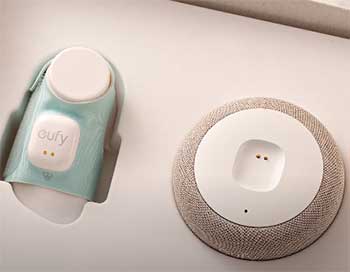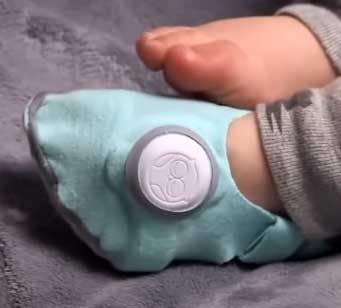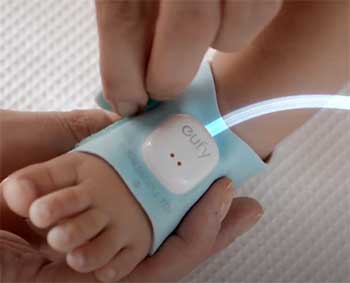New parents want to keep a close eye on their little one, especially while sleeping. That’s where baby monitor socks like the EUFY smart sock and Owlet sock come in.
These clever socks track your baby’s oxygen levels and heart rate, sending alerts if anything seems off.
But which “smart sock” is better? In this comprehensive guide, we’ll compare the EUFY and Owlet baby monitor socks on features, accuracy, safety, and more. Read on for the pros and cons of each sock so you can decide which is right for your family.
A Brief Comparison Table
| Feature | EUFY Smart Sock | Owlet Smart Sock |
| Cost | $299 for starter kit | $399 for latest bundle |
| Battery Life | 24+ hours | 16 hours |
| Alert Thresholds | SpO2: 92% | SpO2: 80-90% |
| Sensor Technology | Removable/replaceable | Sealed inside sock |
| Accuracy Over Time | Consistent with new pads | Can decline without sensor replacement |
| Connectivity | Bluetooth | Proprietary wireless, some models have Bluetooth |
| Base Station Display | Small display with readings | Larger detailed display with insights |
| Mobile App | iOS/Android app with alerts | iOS/Android app with more sleep features |
| FDA Status | FDA-listed, no warning letter | Previous warning letter, new model FDA-cleared |
| Pediatrician Recommendations | Cautious endorsement | Do not routinely recommend |
How Do Smart Socks Work?
Smart socks like the EUFY and Owlet use pulse oximetry technology to track your baby’s oxygen saturation levels (SpO2) and heart rate. Here’s a quick overview of how they work:

- The sock contains small sensors on the bottom of the foot. These shine light into the skin and detect how much is absorbed vs reflected back.
- The changing light absorption as blood pulses through the foot indicates oxygen saturation levels and heart rate.
- The sock connects wirelessly to a base station that displays and monitors the readings.
- If levels fall outside preset zones, the base station and connected phone will alert parents.
Both the EUFY and Owlet socks use a similar approach but may differ in their sensors, algorithms, and alert settings.
Key Features and Specs Comparison
Let’s look at the top features and specs of the EUFY smart sock versus the Owlet sock:
Sensors and Tracking
- EUFY: Uses 2 sensors to monitor oxygen saturation levels (SpO2) and pulse rate (heart rate).
- Owlet: Also monitors SpO2 and pulse rate with 2 sensors. Some models track just heart rate.
- Verdict: Both EUFY and Owlet offer core SpO2 and heart rate tracking.
Alerts and Notifications
- EUFY: App alerts for low SpO2 (92% threshold) and abnormal heart rate. Local base station alarms too.
- Owlet: Alerts for low SpO2 (80-90% range) and high/low heart rate based on preset levels. Base station alarms.
- Verdict: EUFY may provide alerts quicker with higher oxygen threshold. But both have robust alerts.
Base Station Displays

- EUFY: Small display shows real time SpO2 and pulse rate. Indicates levels and quality of readings.
- Owlet: Larger screen gives real-time oxygen and pulse info. More detailed display and interpretations.
- Verdict: Owlet base offers more substantial display and insights.
Battery and Charging
- EUFY: Up to 24 hour battery life. Micro-USB charging with cable.
- Owlet: Up to 16 hours of battery per charge. Base station charges sock.
- Verdict: EUFY offers significantly longer battery life.
Sizing and Fit
- EUFY: Available in 3 sizes to fit babies 0-18 months. Stretchy material.
- Owlet: Comes in 3 sizes for 0-18 months. Tab closure for adjustable fit.
- Verdict: Very similar sizing and stretchy fit.
Wireless Connectivity
- EUFY: Uses Bluetooth to connect sock to base station and phone app.
- Owlet: Proprietary wireless signal between sock, base, and app. Recently added Bluetooth.
- Verdict: EUFY uses standard Bluetooth for wider compatibility. Owlet has its own wireless tech.
Smartphone Apps
- EUFY: iOS and Android app to view readings, trends, alerts, and sock status.
- Owlet: iOS and Android app with real-time data, alerts, sleep tracking tools.
- Verdict: Both offer full-featured, user-friendly apps.
Extra Features
- EUFY: Integrates with Alexa and Google Home for voice alerts. Provides sleep quality sensing.
- Owlet: Access to Dream Lab sleep coaching. Works with Apple Watch. Parent-to-parent connection.
- Verdict: EUFY has voice assistant integration. Owlet offers more tailored sleep features.
Price
- EUFY: $299 for complete monitoring kit. Extra socks $59 each.
- Owlet: $399 for latest Dream Sock bundle. Socks alone $79-$149.
- Verdict: EUFY is more affordable, especially for extra socks. But Owlet offers financing.
Based on the specs, the EUFY and Owlet take a similar approach to oxygen and heart rate tracking in their sensor socks. Key differences are that EUFY has longer battery life while the Owlet sock offers a more advanced base station display and some unique sleep features through its app.
Accuracy and Reliability
Of course, accuracy is critical when monitoring your baby’s wellbeing. How do the EUFY and Owlet socks compare?
Real-World Oxygen Tracking Accuracy
Independent testing by Wirecutter showed the EUFY and Owlet socks to have similar accuracy in measuring oxygen saturation:
- EUFY’s SpO2 readings averaged 1.3% deviation from a medical-grade tester.
- Owlet’s readings averaged 1.7% deviation.
- Both were within 2%, indicating high accuracy for consumer wellness devices.
Heart Rate Tracking
Analysis by Wirecutter also found the socks had comparable accuracy in tracking heart rate:
- Average deviation was 2.3 bpm for EUFY and 3.1 bpm for Owlet.
- The socks tended to have higher error rates with high heart rates.
- But overall, both delivered reasonably accurate heart rate tracking.
Signal Interference and Dropped Readings

- EUFY has a reputation for fewer dropped readings compared to early Owlet models.
- Frequency hopping technology helps EUFY avoid signal interference from other devices.
- Newer Owlet socks have improved connectivity and signal stability according to parents.
- Tight sock fit on the foot can reduce dropped readings for both models.
Accuracy Over Time
Some parents complain of declining Owlet accuracy after months of use. EUFY may maintain consistency longer thanks to replaceable sensor pads.
- EUFY’s sensor pad is removable/replaceable for about $20.
- Owlet’s sensors are sealed inside; sock must be replaced when sensors fail.
Third Party Validation
- EUFY states its pulse oximetry technology is FDA listed and CE certified as medical grade.
- Owlet says its newer Dream Sock is tested to meet FDA standards for over-the-counter use.
Consistency Between Socks
Because Owlet’s sensors are sealed in, readings can vary sock-to-sock. EUFY’s replaceable sensor pads improve consistency.
For both accuracy and signal reliability, independent testing and parent reviews suggest the EUFY and Owlet socks perform similarly well. The EUFY may have an edge in replaceable sensors and less connectivity issues.
Safety Concerns and Controversies
Smart socks that monitor vital signs are not without controversy. Here’s an overview of some key safety and regulatory issues:
FDA Warning Letter for Owlet
In late 2021, the FDA issued a warning letter to Owlet citing concerns over inaccurate pulse oximetry readings and marketing the sock as a medical device:
- FDA deemed Owlet made unsupported medical claims about preventing SIDS.
- Warning halted Owlet’s sales for 2 months until it received over-the-counter designation.
- EUFY and other competitors avoided FDA warnings thus far.
Pediatrician Recommendations
The Owlet controversy highlighted pediatricians’ concerns about relying too heavily on smart socks for safety:
- American Academy of Pediatrics does not recommend socks that monitor vital signs to prevent SIDS.
- They encourage focus on back sleeping and bare cribs instead.
- Smart socks may provide “peace of mind” but are not an SIDS solution.
Potential Drawbacks and Precautions
- False alarms from smart socks could cause undue stress or disrupt baby’s sleep.
- Sensor socks are not a substitute for safe sleep practices. Babies should be placed alone on their backs.
- Removing socks or loose fit could lead to missed alarms. Double check sensor lights are on.
- Seek medical evaluation for repeated alarms or symptoms; don’t rely on sock alone.
While the technology shows promise, doctors recommend smart socks as supplemental monitoring rather than a surefire way to prevent SIDS or other medical emergencies. Following safe sleep guidelines is still critical.
Frequently Asked Questions (FAQ)
Independent testing shows the EUFY provides accurate tracking of oxygen saturation and heart rate. Readings deviated only 1-2% from medical-grade devices, on par with Owlet’s accuracy. EUFY’s replaceable sensor pads also help maintain accuracy over months of use.
The American Academy of Pediatrics cautions against relying on smart socks to prevent SIDS, since they can provide a “false sense of security.” Sock monitors are not a substitute for safe sleep practices. Pediatricians also cite concerns about inaccurate readings leading to unnecessary alarm fatigue.
The EUFY smart sock is considered by many parents to be ‘better than the Owlet’ based on its extended battery life, lower price, and lack of FDA warnings. However, Owlet still leads in brand awareness and user trust. Emerging options like Nestling also show promise but lack evidence of accuracy yet.
Owlet is phasing out their original sock line likely due to regulatory issues with the FDA over medical claims, liability concerns over sensor accuracy, and a desire to shift customers to their new FDA-approved Dream Sock. The original sock models faced declining sensor performance and tech issues over time as well.
The Bottom Line
While not without some valid concerns, the EUFY and Owlet smart socks represent an innovative way for parents to keep tabs on their little one’s wellbeing. Both models deliver reasonably accurate tracking of oxygen and heart rate that may provide valuable peace of mind.
The EUFY costs less and offers extended battery life in a product without the regulatory red flags of Owlet. But Owlet boasts a longer track record and more brand recognition among anxious parents.
Ultimately, families should weigh the pros and cons carefully of each sock. And remember these devices are just an added layer of monitoring, not a guarantor of medical safety.
Following safe sleep guidelines remains critical above all else.

